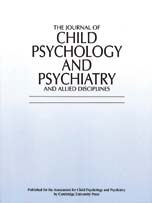Development and Current Functioning in Adolescents with Asperger Syndrome: A Comparative Study
Published online by Cambridge University Press: 14 March 2001
Abstract
Adolescents with Asperger syndrome (AS: without delay in speech development, diagnosed according to ICD-10 clinical criteria) were compared with a group with high-functioning autism (HFA: all with delayed speech development), and a group with conduct disorder (CD). Family and genetic studies suggest that Asperger syndrome and autism form part of the same spectrum, whereas the social impairments in conduct disorder are assumed to have different origins. The aims were to explore the relationships between early speech development and other aspects of functioning in autistic disorders, and to compare autistic and nonautistic social impairments. Early and current behaviour and IQ profiles were investigated.The CD group were clearly different from both the AS and HFA groups. The AS group tended to have less severe early behavioural abnormalities than the HFA group, and were unlikely to have speech abnormalities, but other communicative, social, and restricted/stereotyped behavioural difficulties were largely of a similar pattern to the abnormalities in the HFA group. Eighty per cent of the AS group met criteria for autism on the diagnostic algorithm associated with the Autism Diagnostic Interview-Revised. By adolescence, the AS group were reported to be as abnormal as the HFA group but in structured 1:1 interaction their conversation was better. IQ profile in the AS group showed relative strength on verbal measures, unlike the HFA group, but relatively good performance on the Block Design subtest of the WISC/WAIS was a feature of both the AS and HFA groups. The results indicate closely similar behavioural manifestations may arise by adolescence despite differences in speech development. Follow-up studies and further family investigations will be required to clarify the origins of these and other patterns of autistic development.
Information
- Type
- Papers
- Information
- The Journal of Child Psychology and Psychiatry and Allied Disciplines , Volume 42 , Issue 2 , February 2001 , pp. 227 - 240
- Copyright
- © 2001 Association for Child Psychology and Psychiatry
- 150
- Cited by

